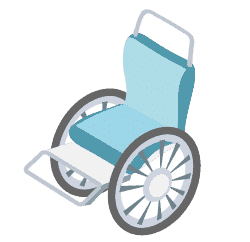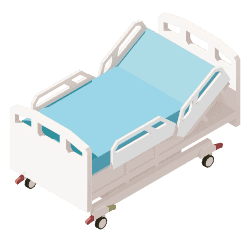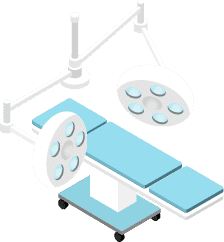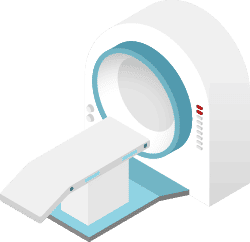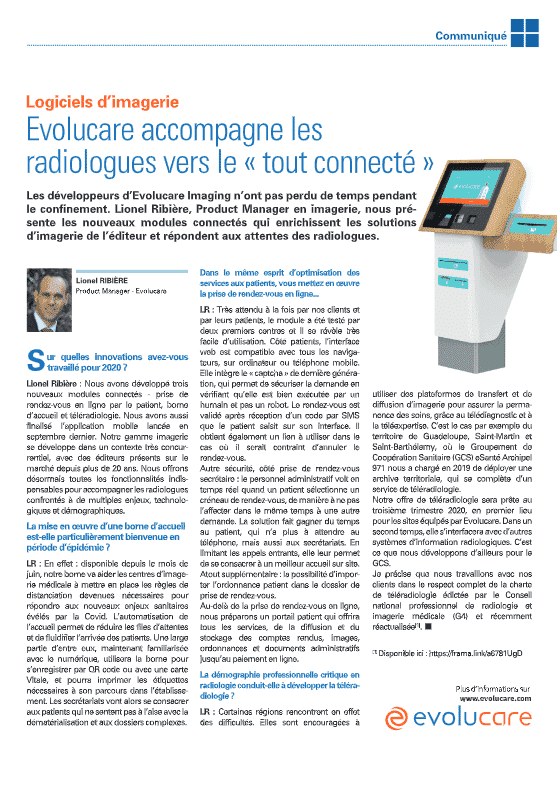Evolucare Imaging’s developers wasted no time during the containment. Lionel Ribière, Imaging Product Manager, presents the new connected modules that enrich the editor’s imaging solutions and meet the expectations of radiologists.
What innovations have you been working on for 2020?
We have developed three new connected modules – online appointment scheduling by the patient, reception kiosk and teleradiology. We also finalized the mobile application launched last September. We are still young
Our imaging range is developing in an already very competitive context, with editors who have been present on the market for more than 20 years.
So we needed to catch up. We now offer all the essential functionalities to support radiologists faced with multiple technological and demographic challenges.
The implementation of a reception kiosk is particularly welcome in times of epidemics?
Indeed! Available since the month of June, the terminal will help medical imaging centres to implement the rules of distancing that have become necessary to meet the new health challenges revealed by Covid.
The automation of the reception area will reduce queues and make the arrival of patients more fluid. A large proportion of them, now familiar with digital technology, will use the terminal to register by QR code or with a Vitale card, and will be able to print the labels necessary for their journey through the establishment.
The secretariats will then focus on patients who do not feel comfortable with dematerialization and complex files.
In the same spirit of optimizing patient services, are you implementing online appointment scheduling?
Highly anticipated by both our customers and their patients, the module has been tested by the first two centres and is proving to be very easy to use.
On the patient side, the web interface is compatible with all browsers, on computer or mobile phone. It integrates the latest generation captcha which makes it possible to secure the connection request to the server by verifying that it is executed by a human and not a robot. The appointment is validated after receiving a code by SMS that the patient enters on his interface. He also gets a link to use in case he is forced to cancel the appointment.
Another security: on the secretary appointment side, the administrative staff receives a real-time alert when a patient selects an appointment slot so as not to assign it at the same time to another request.
The solution saves time for the patient, who no longer has to wait on the phone, but also for the secretaries. By limiting the number of incoming calls, it allows them to devote themselves to a better reception on site.
An additional advantage: it offers the possibility of importing the patient’s digital imaging prescription into the appointment booking file.
In addition to online appointment scheduling, we are already preparing the development of a patient portal that will offer all services, from the distribution and storage of reports, images, prescriptions and administrative documents to online payment.
Professional demographics are still critical in radiology and are leading to the development of teleradiology?
Some regions are indeed encountering difficulties and are being encouraged to use imaging transfer and dissemination platforms to ensure continuity of care through telediagnosis and teleexpertise. This is the case, for example, in the territory of Guadeloupe, Saint-Martin and Saint-Barthélemy, where the Groupement de Coopération Sanitaire (GCS) eSanté Archipel 971 first asked us, in 2019, to set up a territorial archive [1], which will be supplemented by a teleradiology service.
Our teleradiology offer will be ready in the 3rd quarter of 2020, primarily for sites equipped by Evolucare. In a second stage, we have already planned for it to interface with other radiological information systems. This is what we are developing for Guadeloupe.
I would also like to point out that we work with our customers in full compliance with the teleradiology charter issued by the National Professional Council of Radiology and Medical Imaging (G4) and recently updated [2].
What is the status of the mobile application you announced last year?
It is beginning to be adopted and we still have plans to develop it further. This year, we have integrated tools for viewing images, making digital dictation and taking photos directly from the smartphone and integrating them directly into the patient’s file, for example a prescription or a biological assessment, which can then be easily imported into the patient’s file.
[1] Cf Le médecin radiologue – April 2019
[2] Available here : https://frama.link/a6781UgD
